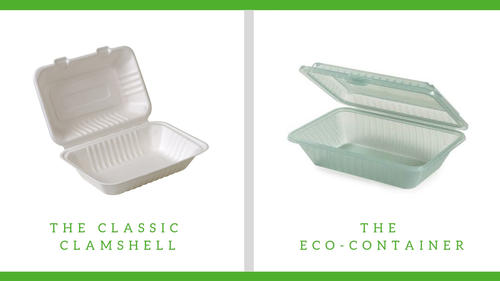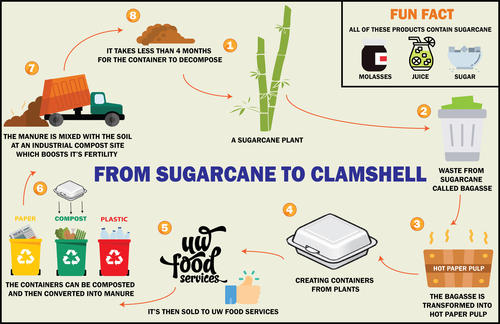When it comes to take-out containers at our eateries, the classic clamshell is often the choice most people make. From pizza to pasta and salads to sandwiches, the clamshells we provide keep food fresh and delicious for eating.

Did you know that they’re even made from bagasse, which is eco-friendly? Bagasse is a fibre that remains after extracting sugarcane juice. Unlike trees, sugarcane is a rapidly growing renewable resource that causes manufacturers to rely less on materials such as styrofoam and plastic, but more on eco-friendly alternatives such as bagasse to create disposable products. Since bagasse is further a byproduct of sugar production, creating disposable take-out containers is a great way to make use of a material that would otherwise be discarded.
From plant to product, the classic clamshell is not only environmentally-friendly but is microwaveable, freezer safe, compostable, and doesn’t deteriorate like most paper containers when exposed to hot liquid. If composted, it only takes an average of 2 to 4 months to decompose in a home compost bin and even less in an industrial compost site. The problem, however, is that most individuals often don’t place these clamshells in the compost bin within our eateries, causing them to end up in landfills that take years for them to decompose.
How does bagasse transform to our classic clamshell?
Take a look at the diagram below to understand the process of how these bagasse clamshells are made.

The classic clamshells we offer are eco-friendly and affordable with a simple charge of $0.30 for each, but why not completely reduce this form of waste for the better of the planet? This was the idea that surrounded the implementation of the eco-container program, where we offer eco-containers for a one-time fee of $5.00 and you can use them again and again! They offer the same easy and familiar shape of the classic clamshell but don’t need to be discarded after one use, making them the ideal take-out containers in times where climate change is most prominent. They are also microwave and dishwasher safe along with being BPA free, ensuring that your food stays safe.
How does the eco-container program work?
The eco-container program is very simple, watch the video below to see how the process works.
From September 2018 to January 2019, approximately 2,593 eco-containers were sold. That’s 2,593 classic clamshells that weren’t discarded! Help us increase this number and make our campus greener by using an eco-container rather than a classic clamshell at any of our residence eateries (REV, V1, and CMH).
References
HuffPost India. (2017). These Containers Made of Sugarcane Are Stronger than Plastic. [online] Available at: https://www.huffingtonpost.in/the-better-india/these-eco-friendly-containers-made-of-sugarcane-are-stronger-tha_a_21644451/ [Accessed 13 Feb. 2019].
Tardiff, R. (2013). What is Bagasse? [online] Greenhome.com. Available at: http://www.greenhome.com/blog/what-is-bagasse [Accessed 13 Feb. 2019].





